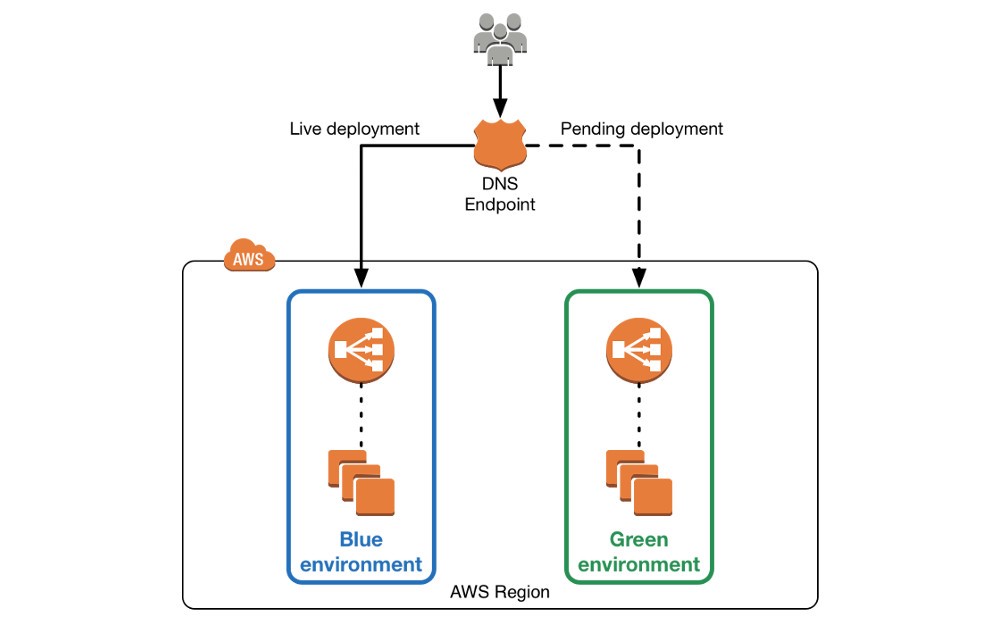In today’s world of software development, where everything moves fast, making sure updates happen smoothly without much downtime is super important. One way to pull this off is with a blue-green deployment. This method helps cut downtime and reduces risk by using two environments—blue and green—so traffic can switch between them without a hitch.
When you bring AWS services into the mix, blue-green deployment becomes an even stronger tool for keeping your apps reliable and available.
In this blog, I’ll dive into how you can set up blue-green deployment on AWS, using services like Elastic Load Balancing (ELB), Amazon EC2, AWS Elastic Beanstalk, Amazon ECS, and Route 53.
What is Blue-Green Deployment?
Blue-green deployment is a method where you run two matching environments: one that’s currently live, called “blue,” and another that’s ready to take over, called “green.” While users are directed to the blue environment, the green one is set up with the newest version of your app. After the green environment is fully tested and working smoothly, you flip traffic from blue to green, making green the live environment.
This quick switch helps keep downtime to a minimum. Plus, if any problems pop up, you can instantly switch traffic back to blue, keeping things stable for users.
Benefits of Blue-Green Deployment:
Zero Downtime: Traffic smoothly transitions between environments without any downtime, so users won’t even notice when updates happen.
Safe Rollback: If any issues crop up in the green environment, you can quickly switch traffic back to the blue environment, keeping things stable.
Isolation of Environments: Each environment is separate, making it easy to thoroughly test new updates before they go live.
Steps to Implement Blue-Green Deployment in AWS:
1. Set Up the Initial Blue Environment:
To get started, you’ll first set up your initial (blue) environment in AWS. This can be a group of EC2 instances, an Elastic Beanstalk environment, or even an ECS cluster if you’re using containers.
Amazon EC2: Launch a set of EC2 instances running your current application. Use an Auto Scaling Group (ASG) to help manage the instances as your traffic needs shift.
Elastic Beanstalk: Create an Elastic Beanstalk environment that hosts your application’s current production version.
Amazon ECS: Deploy your app to ECS, either running on EC2 instances or through Fargate if you prefer serverless.
Finally, make sure your blue environment is linked to an Elastic Load Balancer (ELB) to evenly distribute traffic across instances or containers, keeping your setup efficient and stable.
2. Prepare the Green Environment:
After your blue environment is up and running, the next step is to set up the green environment. This one will host the new version of your app and should have a similar configuration to the blue environment.
Amazon EC2: Launch new EC2 instances with the updated app version in a separate Auto Scaling Group (ASG).
Elastic Beanstalk: Create a new Elastic Beanstalk environment (green) with the latest application version.
Amazon ECS: Deploy the updated app in a new ECS service or task definition.
Be sure to connect the green environment to its own Elastic Load Balancer (ELB). This way, you can test everything thoroughly before switching traffic over.
3. Test the Green Environment:
Before moving traffic to the green environment, thorough testing is essential:
Health Checks: Use health checks to monitor the status of your instances or containers, ensuring everything is responsive and stable.
Comprehensive Testing: Run integration, performance, and security tests to confirm that the environment is functioning as expected without impacting users.
Automation Tools: Consider AWS CodePipeline or other CI/CD tools to automate testing and validation steps, making the transition smoother and more reliable.
4. Switch Traffic to the Green Environment:
Once you’ve confirmed that the green environment is stable, you can begin shifting traffic from the blue to the green environment:
Elastic Load Balancer (ELB): Adjust your ELB listener rules to gradually forward traffic from the blue environment to the green.
Route 53: Update your DNS record in Amazon Route 53 to direct traffic to the green environment’s ELB, enabling a smooth transition.
Now, the green environment becomes live, while the blue environment no longer receives active traffic, making it ready for any rollback or updates as needed.
5. Monitor and Validate the Deployment:
Keep a close eye on the green environment’s performance to make sure it’s handling traffic smoothly:
Amazon CloudWatch: Monitor key application metrics like latency, error rates, and CPU usage to spot any issues early.
ELB Health Checks: Regularly check ELB health checks to confirm that all instances are running healthily.
Log Analysis: Review logs to detect any issues or unexpected behaviors, so you can address them promptly.
6. Decommission the Blue Environment:
If the green environment is performing well, you can go ahead and decommission the blue environment:
Auto Scaling Group (ASG): Scale down the instance count in the blue ASG to zero or delete the ASG entirely.
Elastic Beanstalk: Terminate the blue Elastic Beanstalk environment to free up resources.
Amazon ECS: Shut down any ECS tasks linked to the blue environment.
However, it’s a good practice to keep the blue environment running for a brief period. This way, if any issues pop up with the green environment, you can quickly roll back to the blue environment without any hassle.
7. Roll Back in Case of Failure:
If you encounter any critical issues with the green environment after switching traffic, the blue-green deployment strategy makes rolling back simple:
ELB: Change the traffic rules in your Elastic Load Balancer to redirect traffic back to the blue environment.
Route 53: Update the DNS records to point back to the blue environment’s ELB.
This rollback process helps ensure that any problems with the new version don’t lead to significant downtime or disruptions for your users.
AWS Services That Support Blue-Green Deployments:
AWS Elastic Beanstalk: Elastic Beanstalk offers built-in support for blue-green deployment, making it easy to swap environments with minimal configuration.
AWS CodeDeploy: CodeDeploy has a built-in blue-green deployment strategy that works well with EC2, ECS, and Lambda functions.
Amazon ECS: With ECS, you can create new task definitions for the green environment and use an ELB or Application Load Balancer (ALB) to shift traffic.
Bottomline:
Implementing blue-green deployments in AWS allows you to minimize downtime and reduce risks associated with deploying new versions of your application. By leveraging AWS services like Elastic Load Balancer, Route 53, and Auto Scaling Groups, you can build highly available, scalable, and resilient environments that ensure seamless transitions between application versions.
Blue-green deployment is a powerful strategy for improving the reliability and availability of your applications, and AWS provides the tools and services to implement it efficiently.
About Euphoric Thought Technologies –
Euphoric is an IT firm providing end-to-end product development services with its deep technical expertise and industry experience. The offerings include DevOps, Cloud Computing, Application Development, Data Science and Analytics, AI/ML, and ServiceNow consulting. You can contact us here to learn more about Euphoric.







